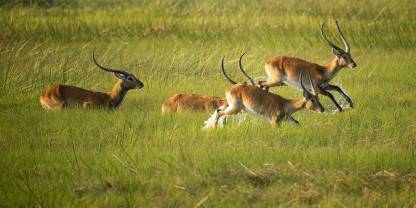Average Expert Rating
Rating Breakdown
Write a User ReviewA seasonal haven for the Kafue lechwe
Read more
With nowhere else to go, we sat back and waited for the sunset. And, as the wetland was glowing in the last rays of sunshine, we knew we had made the right call visiting this neglected haven for the endangered Kafue lechwe.Bird-rich park, close to Zambia’s capital
Blue Lagoon National Park is in many ways the poor relation of its far larger neighbour Kafue, to the west, and, Lochinvar, which lies to the south, on the opposite side of the Kafue River. In my opinion, the main reason to consider coming to this flat, marshy expanse of bush rather than Kafue would be to take advantage of its proximity to Lusaka, which is only 120km away by road.
If you do make the trip, you could be rewarded with some excellent birdwatching, especially in the southern section. The park doesn’t reach as far south as the Kafue River, but it includes grasslands which flood when the river is high and harbour many water-loving bird species, along with large herds of Kafue lechwe. In the northern half, where the terrain is drier, animals are rather scarce.
A neglected bird-watcher’s paradise
The focal point of Blue Lagoon is a motorable 5km causeway that leads through the floodplain to a stilted viewing platform. From the causeway, we saw large numbers of aquatic birds, including spur-winged goose, rufous-bellied heron, black egret, saddle-billed stork and coppery-tailed coucal. Highlights included a lesser jacana with chicks treading across the floating vegetation, and a family of very screechy barn owls that evidently nest in the reception building next to the campsite.
From the viewing platform at the end of the causeway, we enjoyed panoramic views over the swamp, and saw
Read more
several hundred-strong herds of Kafue lechwe, a striking semi-aquatic antelope whose range is more or less confined to the Kafue Flats. Other than a troop of vervet monkeys that evidently lurks around the campsite, lechwes were the only large mammals we saw in Blue Lagoon.We were fortunate to visit Blue Lagoon after the first rains, which meant the water was sufficiently high to enjoy good bird watching from parts of the causeway. By all accounts, there's a lot less to see in the Dry season, when the marsh often retreats beyond the end of the causeway. By contrast, the bird watching must be pretty incredible at the height of the rainy season.

